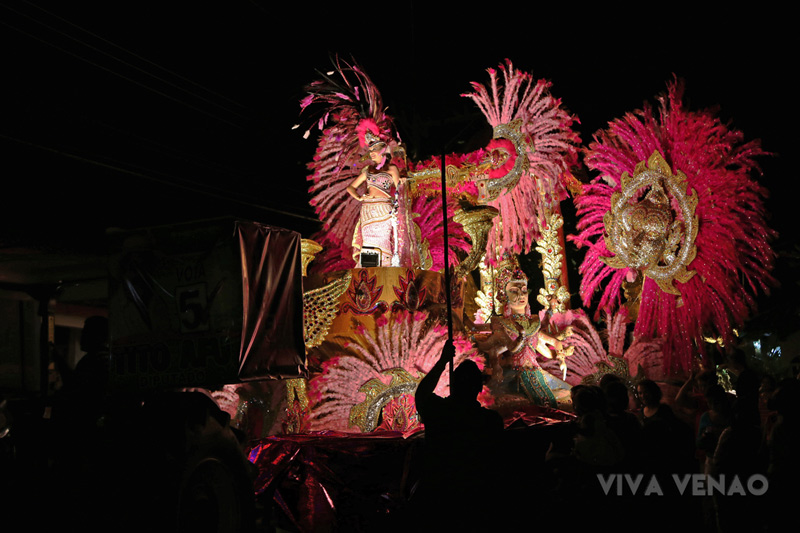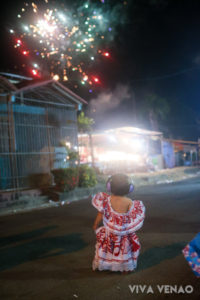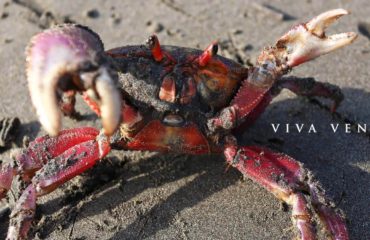Made with ♥ by Aya Andrews. All Rights Reserved © 2013-2018.
El Carnaval Panameño
What is Carnaval?
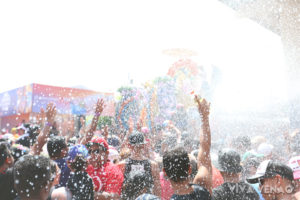
culecos Las Tablas Carnaval 2017
Carnaval is the four-day traditional celebration that takes place immediately before Christian Lent (which starts on Ash Wednesday), and is celebrated each year from Friday night through the morning of Ash Wednesday in February or March of each year. Each year a massive budget is spent on elaborate floats and costumes, water trucks, and security. People save up money, pawn household goods, and quit their jobs to have enough money and time to enjoy Carnival.
Most of Panama City leaves for the big festivals in the culture-rich Interior (Azuero Peninsula). The most popular festivals in Las Tablas, Chitre, and Pedasi feature massive parties and are televised nationally. All businesses shut down for the holidays. Streets get closed down. Hotels fill up a year in advance.
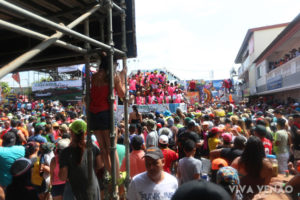
Las Tablas Carnaval 2017
Everyone wears bright colors and carry their money and phone in a plastic case that they wear around their necks, as during the day, water trucks (culecos or mojaderas) emerge on the streets with water hoses. Kids load up their water guns and buckets with ice water. Discotecas (dance halls) set up stages on the street featuring performances by national and international artists. Local music (músico típico) is played by accordions, drums. Big parades of floats carrying the queens and princesses, a brass band, and fireworks occur day and night, for ~3 hours starting 12pm and 12am each day. Vendors set up street stalls, where food and trinkets (hats, clothing, water guns) are sold. The dancing, drinking, and festivities continue day and night. Kids and babies can be seen out even past midnight! On the morning of Ash Wednesday, all the remaining fireworks are burned in a massive (and extremely loud!) bonfire (quema de cohetes), after which Lent begins and meat is given up in favor of fish.
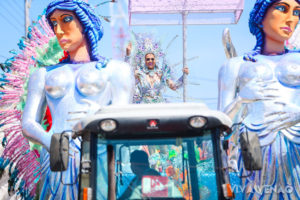
Sunday Calle Arriba Pedasi 2017
The town splits down the middle, and people are passionate in their support for Calle Arriba/Abajo based on where they reside in town. Each queen and royal court ride a big float up and down the streets (paseo), lit by fireworks and followed by a brass band (murgas) to rally supportive cries for their respective queens. A crowd of supporters (tunas) follow and dance behind the floats.
Many villages feature two queens – one from Calle Arriba (uptown, or above the main street) and one from Calle Abajo (downtown, or below main street), who battle it out (Topón) over who will reign supreme during the four-day festivities. They compete in attire, floats, amount of money spent, fireworks, band, and a final mock battle. The queens are groomed from childhood having ridden the floats as princesses (Royal Court or corte real) and fundraise tens of thousands of dollars to adorn their floats. They are typically between 18 and 22 years of age. Many (if not most) study or reside in Panama City but must have ties to the village which they reign. The tunas of each queen are headquartered in different parts of the town. Calle Arriba is headquartered near the church square (Pedasi) and near La Bolivar Street (Las Tablas). Calle Abajo is headquartered near the elementary school (Pedasi) and near Punta Fogon (Las Tablas).
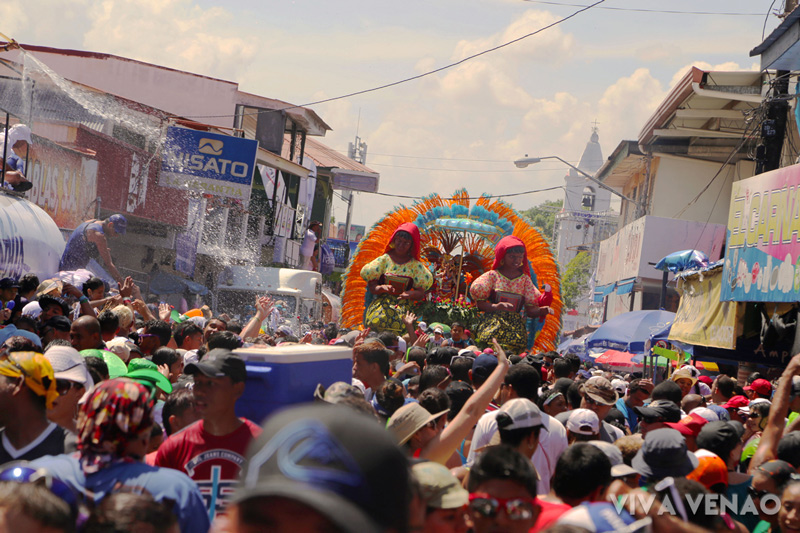
Las Tablas Carnaval 2014
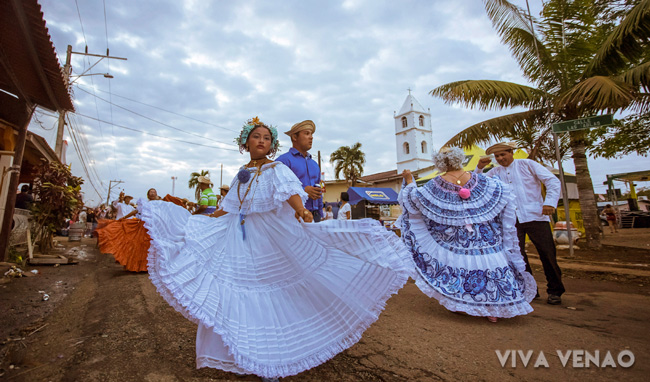
Pollera Tuesday Carnaval Pedasi 2015
History
Carnival is said to have origins in the 18th century during the 3-century Spanish colonization. During this era, the festival was deeply colored by European practices of throwing water and flour, using masks, costumes, and musical instruments like violins, and Spanish items like guitars and polleras (cultural garb). From 1900-1950, the participants of each tuna would meet at beaches, ravines, or rivers to eat, drink, dance, and socialize. From the 1950s the Las Tablas Carnival established the queens of Calle Arriba/Abajo and the first street band and water trucks were introduced, and carnival became a large national event. From the 1980s, discotecas arrived to set up street parties in caged areas blasting Panamanian music (musico tipico) and modern hits.
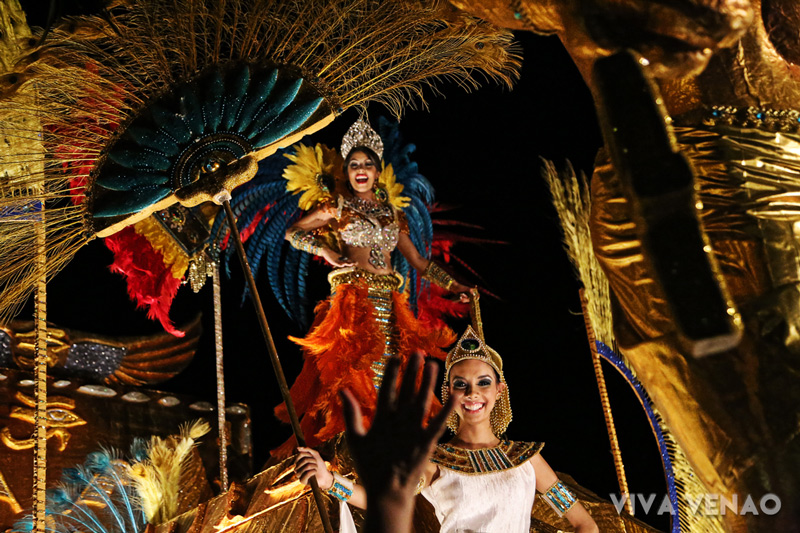
Calle Abajo Pedasi 2014
When is it?
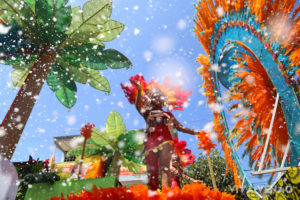
Court Real Las Tablas 2014
2017: February 24th – 28th
2018: February 9th – 14th
2019: March 1st – 6th
2020: February 21st – 26th
2021: February 12th – 17th
2022: February 25th – March 2nd
2023: February 17th – 22nd
2024: February 9th – 14th
2025: February 28th – March 5th
2026: February 13th – 18th
2027: February 5th – 10th
2028: February 25th – March 1st
2029: February 9th -14th
2030: March 1st – 6th
Schedule of Activities
Friday – Coronation
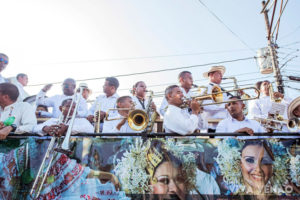
Murgas Las Tablas
The festivities start around 12am. Fireworks will go off, the floats will start mozying down the streets, and around 12:30am or so the 2 queens will become visible. Coronation starts ~12:30am-1am. The official events start winding down around 2-3am at which time the discotecas turn up their music and the drinking/dancing continues until morning.
Saturday
Theme: disguise. Queens come dressed in costume.
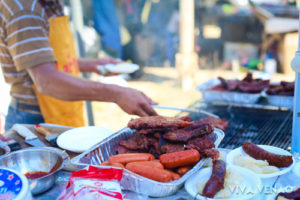
street food carnaval panama
Daytime: from 12pm the culecos (water trucks) will start spraying water. Eager kids will fill up buckets and water guns with ice and head out to town where they will “attack” anyone who is still dry! Most cities host foam & water parties, and discotecas will keep the stages (featuring national and international musical artists) going all day long. The tunas will emerge around 12-12:30pm and will parade until 2:30pm.
Nighttime: From 12am the floats emerge again carrying the queens. The parade and fireworks wind down around 2am and the dancing/drinking continues until morning (5am).
Sunday
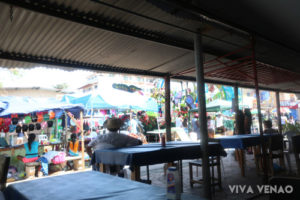
Man watches Las Tablas Carnaval
Theme: coronation. Queens come out in their coronation dresses and their cars are adorned with a coronation theme.
Events same as Saturday.
Monday
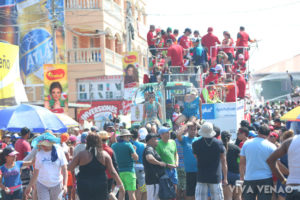
Parade ends in Las Tablas
Theme: luxury. Queens dress in a giant disguise and is a gala day.
Events same as Saturday.
Tuesday (Shrove/Fat Tuesday)
Daytime: same as previous days.
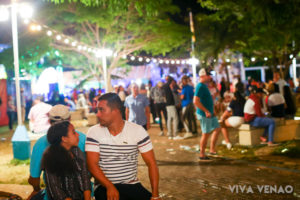
Pedasi Carnaval 2017
Nighttime:
- 7pm (arrive at 6pm) – (Pedasi) the queens and ladies of the town will emerge in fancy polleras and men in traditional attire (straw hats, white linen shirts, black pants, leather sandals).
- 12-1am : The parades wind down (Pedasi).
- 2am : Quema de Cohetes (Pedasi). All the fireworks that did not get used will be lit in a massive bonfire.
- (Panama City) El entierro de la sardina (burial of the sardine) : a New Orleans style funeral with costumes, music, dancing, and fake tears.
- 5am : Quema de Cohetes (Las Tablas)
- 6am: (Las Tablas) The firefighters put out the fire (takes about 30 mins) and el último Topón (the final showdown) commences between the two rival tunas. As the sun comes up, the brass band amps up the noise and the two queens meet in front of the Church of Santa Librada amid huge crowds. A mock battle will commence where the queens will “fight it out” face to face by trash talking – throwing out props like money, gold fans, cockroaches, handcuffs, and figures of scorpions to taunt and take a personal jab at either the opposing queen or her family. For example, in 2016, the queen of Calle Abajo told Calle Arriba that she is “little and ugly,” with the insult accompanied by a tape measure. Each will declare herself the winner of Carnival.
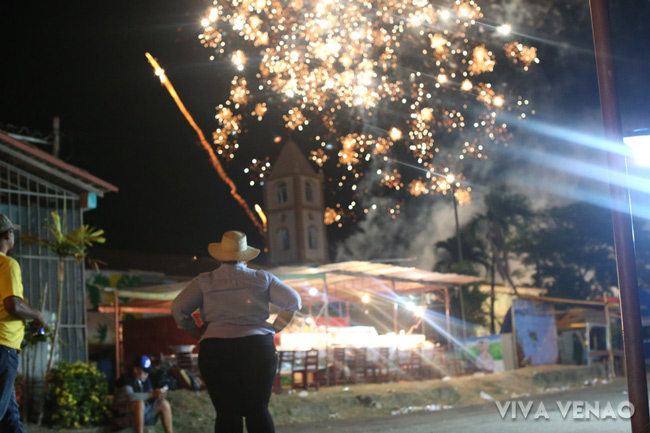
Fireworks Pedasi Carnaval 2017
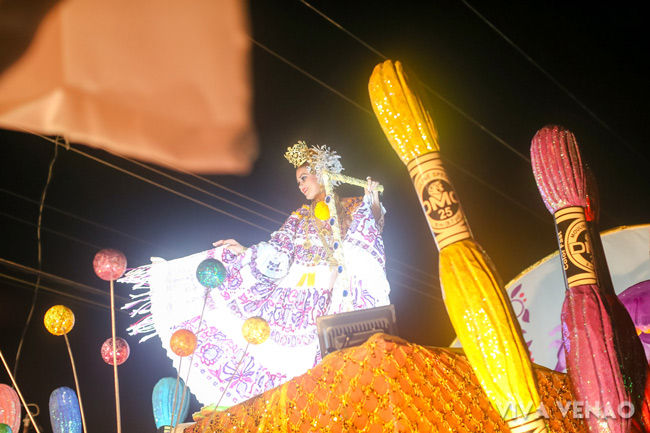
Pollera Calle Arriba Pedasi 2017
Dress Code
Bright colors. During the daytime, dress to get wet. Put your phone/money in plastic cases.
Where to Go
The Big Three
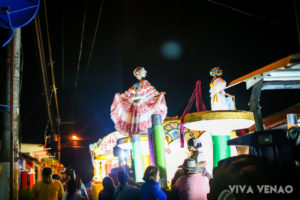
Pollera Calle Arriba Pedasi 2017
- Las Tablas
- Chitre
- Pedasi
The others (less crowded and more local)
- La Villa de Los Santos
- Santo Domingo
- San Jose
- La Palma

Fireworks Pedasi Carnaval 2017
- Tonosi
- Capira
- Lajamina
- Parita
- Ocu
- Guarare
- Penenome
- Aguadulce
- Santiago
- Panama
- Chiriqui
The Aftermath
Carnivalito
A village festival on the Friday-Sunday after Carnival. In Pedasi on Sunday, a bull will run through the church square around noon.
Semana Santa
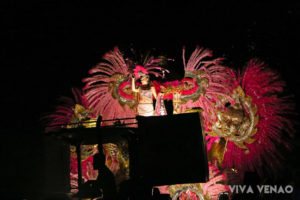
Calle Arriba Pedasi 2014
6 weeks later, the country again closes for the Easter holidays. Business holiday starts on Thursday, and goes through Easter Sunday. Be aware as all of Panama City heads for the beaches (from Coronado to Cambutal) and traffic jams easily cause 3-4 hour delays in and out of the city. No alcohol is sold anywhere on Good Friday.
